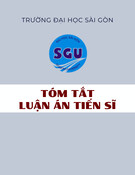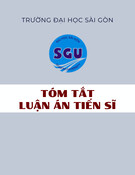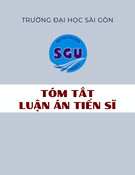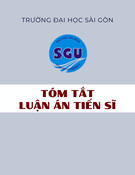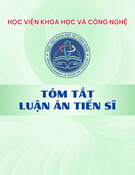
MINISTRY OF EDUCATION
AND TRAINING
MINISTRY OF HEALTH
NATIONAL INSTITUTE OF HYGIENE AND EPIDEMIOLOGY
NGUYEN TAI DUNG
CURRENT STATUS OF HEARING LOSS, ITS
RELATED FACTORS AND THE EFFECTIVENESS OF
PREVENTION BY SUPPLEMENTING Mg-B6 AMONG
THE SOLDIERS OF ARMORED TANK ARMY
IN 2017-2018
Major: Sociological hygiene and Health organization
Code: 62.72.01.64
SUMMARY OF PhD THESIS ON MEDICINE
HANOI - 2021

i
THIS THESIS WAS PERFORMED AND COMPLETED AT
THE NATIONAL INSTITUTE OF HYGIENE AND
EPIDEMIOLOGY
Scientific supervisors:
1.
Prof. Nguyen Tran Hien
2.
Dr. Doan Thi Thanh Ha
Counter arguer 1:
Counter arguer 2:
Counter arguer 3:
This doctoral thesis will be defended at the Dissertation Committee
of Institutional level at:
National Institute of Hygiene & Epidemiology
on 2022
The doctoral thesis can be found at:
1. The National Library
2. The Library of National Institute of Hygiene
and Epidemiology

ii
TABLE OF CONTAIN
A. INTRODUCTION ............................................................................... 1
1. The necessity of the thesis ................................................................ 1
2. Study objectives ............................................................................. 2
3. New contributions of the thesis ......................................................... 3
4. Value of Thesis. ................................................................................ 4
5. Thesis structure ................................................................................. 4
B. THESIS CONTAIN ............................................................................. 4
Chapter 1. LITERATURE REVIEW ........................................................ 4
1.1. The concept of hearing loss ........................................................... 4
1.2. Situation of hearing loss in the military environment .................... 4
1.3. Factors related to hearing loss ........................................................ 5
1.4. Measures to prevent hearing loss ................................................... 6
Chapter 2. STUDY SUBJECTS AND METHODS .................................. 7
2.1. Study subjects ................................................................................ 7
2.2. Research methods .......................................................................... 8
2.3. Sample size and sample selection method .................................... 8
2.4. Data processing ............................................................................ 10
2.5. Research ethics ............................................................................. 10
Chapter 3. RESULTS .............................................................................. 11
3.1. Current status of hearing loss and some related factors ............. 11
3.2. The effectiveness of Mg-B6 supplement in prevention of hearing
loss ...................................................................................................... 14
Chapter 4. DISCUSSION ....................................................................... 17
4.1. Current situation of noise, hearing loss and related factors among
armored tank soldiers in 2017 ............................................................. 17

iii
4.2. The effectiveness of intervention with Mg-B6 supplement for
prevention of hearing loss among the soldiers of the Armored Tank
Army ................................................................................................. 20
4.2.1. The characteristics of intervention and control groups ............ 20
4.2.2. The effectiveness of Mg-B6 supplement in prophylaxis treatment
for hearing loss due to the noise ......................................................... 20
CONCLUSION ....................................................................................... 22
1. Current status of hearing loss and related factors in the soldiers of
Armored Tank Army in 2017 ............................................................. 22
2. The effectiveness of Mg-B6 supplement in preventing hearing loss
............................................................................................................ 24
RECOMMEDATION ............................................................................. 25
LIST OF PUBLISHED SCIENTIFIC ARTICLES RELATED TO THE
THESIS .................................................... Error! Bookmark not defined.

1
A. THESIS INTRODUCTION
1. Necessity of the thesis
Hearing loss is still a big problem in society today. WHO
estimates that around 430 million people (5.5% of the population) in
the world have hearing loss (HL) and it is expected that this number
will increase to 700 million by 2050. Viet Nam currently has no
complete data about rate of hearing loss.
There are many causes of hearing loss, including age-related noise
increases the prevalence of hearing loss; diseases of the ear- nose-
throat and other diseases that might also affect hearing. In addition,
other factors such as genetics, use of drugs that are toxic to the inner
ear, lifestyle habits such as smoking, overuse of headphones, etc. also
have a significant impact on hearing. According to WHO, 50% of
hearing loss cases are preventable based on public health measures.
Exposure to loud and prolonged noise causes hearing loss among
the workers and soldiers of the military. WHO estimates that around
360 million people worldwide have severe hearing loss and around 1.1
billion young people (aged 12 to 35 years) are facing noise-induced
hearing loss.
Hearing plays an important role in soldier's performance of duties
as well as command processing in practical trainings. In many cases,
the noise intensity in the military exceeds the permissible threshold,
so even though "dual" hearing is protected, hearing is still affected.
Unlike civilian labor, soldiers are forced to complete their duties under
all circumstances. Soldiers in some special services such as artillery,
submarines and armored vehicles are often exposed to high-intensity
noise. The sound intensity of the light anti-tank gun is 184 dB, the











